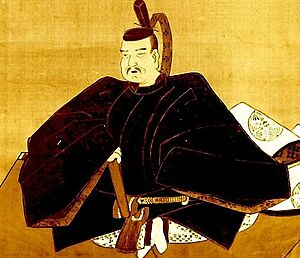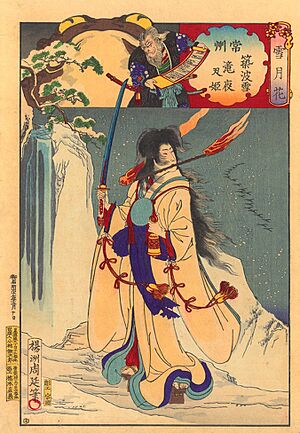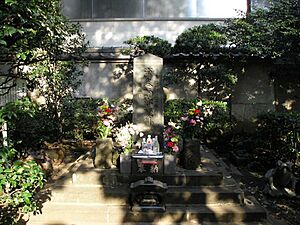Taira no Masakado facts for kids
Quick facts for kids
Taira no Masakado
|
|
|---|---|
| 平将門 | |

|
|
| Born | Unknown; c. early 900s? |
| Died | 14th day of the 2nd month, Tengyō 3 (March 25, 940) |
| Resting place | Masakado-zuka, Ōtemachi, Tokyo (head) Enmei-in, Bandō, Ibaraki (body) |
| Other names | Taira no Kojirō Masakado (平小次郎将門) Sōma no Kojirō (相馬小次郎) |
| Known for | Rebelling against the central government |
| Children | Yoshikado Masakuni Haruhime (Nyoshun-ni) Nyozō-ni (Jizō-ni) Satsukihime (Takiyashahime) |
| Parents |
|
Taira no Masakado (平将門), who died on March 25, 940, was a powerful leader and samurai from eastern Japan during the Heian period. He is famous for leading the very first recorded uprising against the central government in Kyōto. His rebellion was a major event in Japanese history.
Contents
Who Was Taira no Masakado?
Masakado was a son of Taira no Yoshimasa (also known as Yoshimochi). His family, the Kanmu Taira clan, were descendants of Emperor Kanmu (who ruled from 781 to 806). These royal family members were given the Taira surname and became commoners.
Masakado's grandfather, Prince Takamochi, was appointed a vice-governor in Kazusa Province (now central Chiba Prefecture) in 889. His sons, including Masakado's father, held important jobs in eastern Japan. These jobs included being a commander of the defense army in Mutsu Province. This army was tasked with controlling the Emishi people in the north.
Masakado's Early Life
We don't know much about when Masakado was born or his early life. Records from later centuries suggest he was the second or third of his father's sons. He might have been nicknamed Sōma no Kojirō (meaning "little second son of Sōma"). This suggests he grew up in the Sōma area of Shimōsa Province.
Historians think Masakado was born around the year 900. Later stories even said he was the return of a famous scholar named Sugawara no Michizane.
When Masakado was a teenager, he went to the capital city of Heian-kyō (which is now Kyoto). He worked for the powerful imperial regent, Fujiwara no Tadahira. Masakado hoped to get a job in the imperial police force. However, he didn't get a high rank or an important position, even with his family background and powerful boss.
The Jōhei-Tengyō Rebellion: A Family Feud Turns Big
Historians disagree about why Masakado's rebellion started. Some say it was because he didn't get a government job. But an old book called the Shōmonki says it began in 931. It was a fight between Masakado and his uncle, Taira no Yoshikane, over a woman.
This woman might have been Yoshikane's daughter, who married Masakado and moved in with him. This was unusual for the time, as wives usually stayed with their own families. This might have made Yoshikane angry. Another idea is that Masakado and Yoshikane fought over a daughter of Minamoto no Mamoru. Mamoru was a former official who had married his daughters to Masakado's uncles.
Other stories say Masakado's uncles took over land that he should have inherited from his father. His uncle, Taira no Kunika, who was the head of the clan, might have tried to take control of his younger brother's property. Kunika was also related to Mamoru, who later got involved in the conflict.
First Battles (931–936)
In 935, Masakado and his men were attacked by Mamoru's three sons. This happened in a place called Nomoto, near the border of Hitachi and Shimōsa. Masakado's group fought back and won. All three of Mamoru's sons died in the battle. In return, Masakado burned and robbed the homes of those who supported Mamoru's sons. Kunika also died during this time. He might have been killed in the fight or when Masakado burned his home.

Later that year, Taira no Yoshimasa, another uncle or cousin of Masakado, fought him. Yoshimasa wanted to get revenge for Kunika and Mamoru's sons. Masakado won again, and many of Yoshimasa's men were killed.
After this big loss, Yoshimasa asked Yoshikane for help. Yoshikane was the vice-governor of Kazusa Province. He gathered a huge army from Kazusa and Shimōsa. On June 26, 936, Yoshikane led his large army to Hitachi. He joined forces with Yoshimasa and Kunika's son, Taira no Sadamori. Sadamori had been in the capital when his father died and at first stayed out of the fight.
Masakado met them at the border between Hitachi and Shimotsuke. He had only about a hundred soldiers, and they were not well-equipped. But Masakado still managed to cause great damage to his enemies' army of thousands. Yoshikane and his remaining forces fled. Masakado chased them and surrounded his uncle in the government offices. However, Masakado let Yoshikane escape. He then complained to the local authorities before going back to his own land.
Soon after his victory, Masakado was called to the imperial court in Kyoto. Minamoto no Mamoru had complained about the battle at Nomoto. Masakado quickly went to the capital to explain what happened. His boss, Fujiwara no Tadahira, likely helped him. Masakado was pardoned in 937. This happened when a general pardon was given because Emperor Suzaku became an adult.
Continued Conflict (937-938)
Yoshikane wanted revenge for his defeat. He immediately started fighting Masakado again after Masakado returned home. First, he attacked Masakado near the Kogai River. Yoshikane showed pictures of Masakado's father and grandfather to try and lower his soldiers' spirits. This worked, and Masakado's men retreated.
Afterward, Yoshikane burned a stable and some houses at Masakado's base. This was to weaken Masakado's ability to fight. Masakado fought back a few days later. But he was defeated again because he had a severe pain in his legs. During his retreat, Masakado sent his wife (who was Yoshikane's daughter) and children away by boat to keep them safe. But Yoshikane found them and took them to Kazusa. Eventually, the woman's brothers allowed them to escape back to Masakado.
Masakado's Final Stand and Death (939-940)
In 939, Masakado led a larger rebellion, sometimes called the Tengyō no Ran. The fighting began when Masakado attacked a government outpost in Hitachi Province. He captured the governor there. In December of that year, he took over Shimotsuke Province and Kōzuke Province. He then declared himself the "New Emperor" (Shinnō).
The central government in Kyoto responded by offering a reward for his capture. Fifty-nine days later, his cousin Taira no Sadamori, whose father Masakado had killed, and Fujiwara no Hidesato found and killed him. This happened at the Battle of Kojima in Shimōsa Province in 940. They took his head to the capital.
What Happened After Masakado's Death?
Masakado's head was brought to Shibasaki. This was a small fishing village that later became Edo, and then Tokyo. His head was buried there. This burial site, called a kubizuka (head grave), is in the Ōtemachi area of Tokyo today. At the time, it was on a hill overlooking Tokyo Bay. Over many centuries, land was added, and the bay is now much farther away.
Masakado Becomes a God
When Masakado was getting ready for his rebellion, many butterflies appeared in Kyoto. People saw this as a sign of the big battle to come.
Over hundreds of years, Masakado became like a demigod to the local people. They were impressed by his fight against the government. They also felt they needed to calm his vengeful spirit (onryō). People believed that the success of Edo and Tokyo depended on how much respect was shown to the shrine built for him at the kubizuka. If the shrine was ignored, natural disasters and bad luck would follow.
Because of this, the shrine is still well-kept today. It sits on some of the most expensive land in the world, in Tokyo's financial district, facing the Imperial Palace. His tomb (which only has a monument to his head) is near exit C5 of Tokyo's Ōtemachi subway station.
Other shrines where Masakado is honored include Kanda Shrine (in Kanda) and Tsukudo Jinja (which has several locations).

In Gifu Prefecture, there is a Mikubi shrine dedicated to Taira no Masakado. A local legend says that a priest prayed to a Shinto deity (kami) to stop Masakado's head from returning to Kantō for revenge. The kami shot the head with a bow (yumi) as it flew back. The Mikubi Shrine was built where the head supposedly fell.
Images for kids
-
Emperor Kanmu, 50th emperor of Japan. Masakado's family, the Kanmu Heishi, came from Kanmu's children who were not eligible to be emperor.
-
Masakado attacking an opponent on horseback (Yoshitoshi).
See also
- Fujiwara no Sumitomo, another rebellion leader from the same time
- Kaze to Kumo to Niji to, a Japanese drama
- Yoshikawa Eiji, historical fiction writer
- Teito Monogatari, a historical fantasy novel where Masakado's curse affects Tokyo
- Myōken
- Chiba clan
- Sōma clan - The Soma Nomaoi horse-riding festival, started by Taira no Masakado, is still celebrated today.



